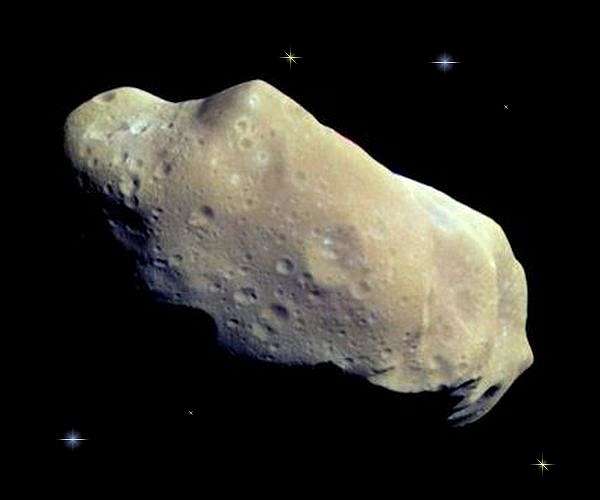
NASA and HAARP conclude asteroid experiment (Image Credit: Space Daily)
A powerful transmitter in remote Alaska sent long wavelength radio signals into space Tuesday with the purpose of bouncing them off an asteroid to learn about its interior.
The asteroid, 2010 XC15, is estimated to be about 500 feet across and is passing by Earth at two lunar distances, which is twice the distance between the Earth and the moon.
Results of Tuesday’s experiment at the High-frequency Active Auroral Research Program research facility at Gakona could aid efforts to defend Earth from larger asteroids that could cause significant damage.
“We will be analyzing the data over the next few weeks and hope to publish the results in the coming months,” said Mark Haynes, lead investigator on the project and a radar systems engineer at NASA’s Jet Propulsion Laboratory in Southern California. “This experiment was the first time an asteroid observation was attempted at such low frequencies.
“This shows the value of HAARP as a potential future research tool for the study of near-Earth objects,” he said.
Several programs exist to quickly detect asteroids, determine their orbit and shape and image their surface, either with optical telescopes or the planetary radar of the Deep Space Network, NASA’s network of large and highly senstive radio antennas in California, Spain and Australia.
Those radar-imaging programs don’t provide information about an asteroid’s interior, however. They use signals of short wavelengths, which bounce off the surface and provide high-quality external images but don’t penetrate an object.
Long wavelength radio signals can reveal the interior of objects.
HAARP, using three powerful generators, began transmitting chirping signals of long wavelength at 2 a.m. Tuesday and continued sending them uninterrupted until the scheduled end of the 12-hour experiment.
The University of New Mexico Long Wavelength Array near Socorro, New Mexico, and the Owens Valley Radio Observatory Long Wavelength Array near Bishop, California, are also involved in the experiment.
Data analysis is expected to take several weeks.
The Tuesday experiment also served as a test for probing an asteroid larger than 2010 XC15.
Asteroid Apophis, discovered in 2004, will make its closest approach to Earth on April 13, 2029. It will come within about 20,000 miles of Earth, closer than the many geostationary satellites orbiting the planet.
Apophis, which NASA estimated to be about 1,100 feet across, was initially thought to pose a risk to Earth in 2068, but its orbit has since been better projected by researchers and is now not a risk to the planet for at least a century.
Tuesday’s test follows tests in January and October in which scientists bounced long-wavelength signals off the moon in preparation for this week’s experiment.
Haynes said understanding the makeup of an asteroid’s interior, especially of an asteroid large enough to cause major damage on Earth, can increase the chances of an effective defense. Knowing the distribution of mass within a dangerous asteroid could help scientists target devices designed to deflect an asteroid away from Earth.
Amateur scientists from around the world reported receiving the outgoing transmission, said Jessica Matthews, HAARP’s program manager. The reports will help infer the conditions of the ionosphere during the experiment.
“Our collaboration with JPL is not only an opportunity to do great science but also involves the global community of citizen scientists,” she said. “So far we have received over 300 reception reports from the amateur radio and radio astronomy communities from six continents who confirmed the HAARP transmission.”
The University of Alaska Fairbanks operates HAARP under an agreement with the Air Force, which developed and owned HAARP but transferred the research instruments to UAF in August 2015.
Related Links
High-frequency Active Auroral Research Program
Space Technology News – Applications and Research
|
|
Tweet |
|
|
|
We need your help. The SpaceDaily news network continues to grow but revenues have never been harder to maintain. With the rise of Ad Blockers, and Facebook – our traditional revenue sources via quality network advertising continues to decline. And unlike so many other news sites, we don’t have a paywall – with those annoying usernames and passwords. Our news coverage takes time and effort to publish 365 days a year. If you find our news sites informative and useful then please consider becoming a regular supporter or for now make a one off contribution. |
||
|
SpaceDaily Monthly Supporter $5+ Billed Monthly |
SpaceDaily Contributor $5 Billed Once credit card or paypal |
|
NASA, Alaska researchers to scan asteroid with radio waves
Washington DC (UPI) Dec 27, 2021
Researchers are preparing for a potentially “catastrophic” close encounter with an asteroid in 2029 by scanning an asteroid with radio waves on Tuesday.
NASA is teaming with scientists from the University of Alaska Fairbanks’ Geophysical Institute to send about 9.6 million radio waves to 2010 XC15, an asteroid that will pass by about twice the distance from Earth to the Moon.
The asteroid is estimated to be about 500 feet wide. Long wavelength radio waves will be transmitted from the Hig … read more








